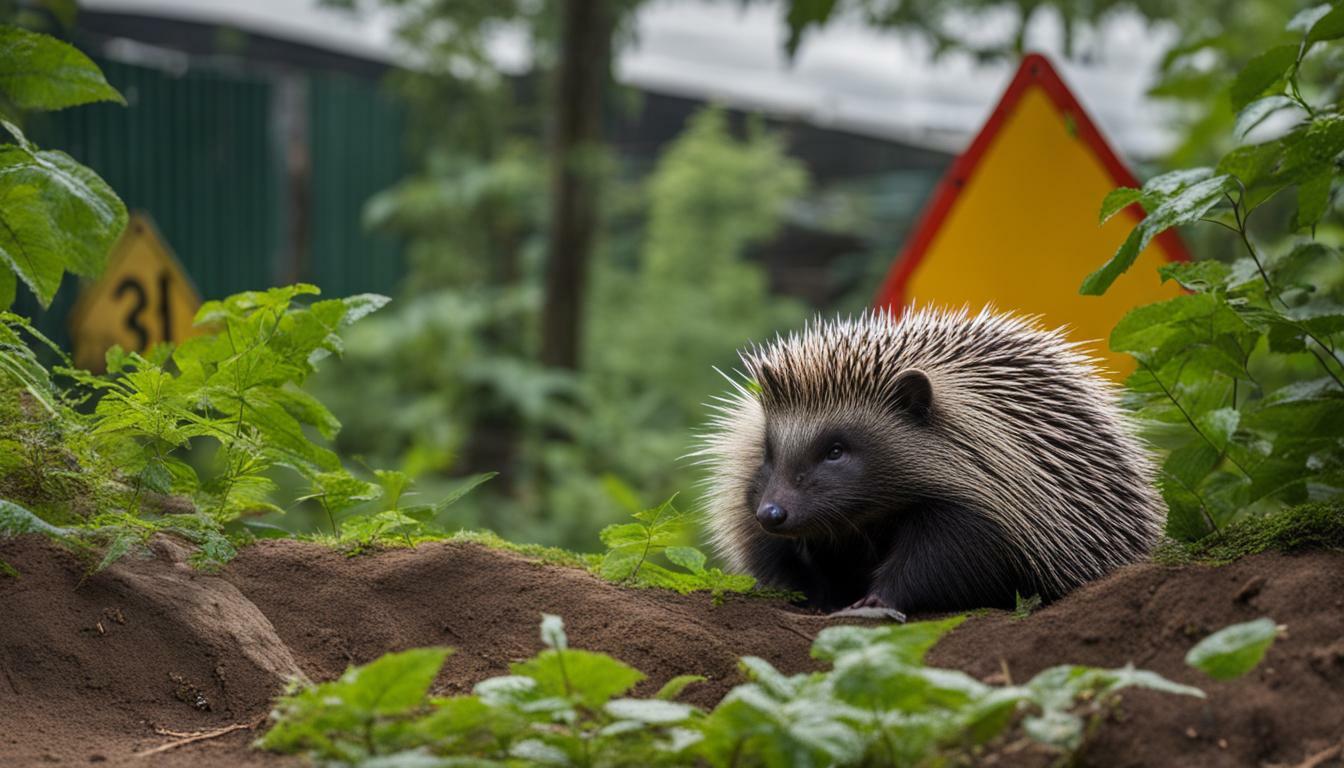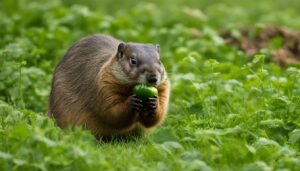Porcupines are fascinating creatures, but are they an endangered species? While porcupines, particularly the North American porcupine, are not globally rare or federally listed as endangered, there are concerns about their population decline in certain regions. Factors such as habitat loss, changes in forestry practices, and hunting for their bezoars have contributed to their decline, especially in Southeast Asia. Porcupines are also hunted for their meat, which is considered a delicacy in some countries. Urgent research and conservation efforts are needed to protect porcupine populations from further decline.
Key Takeaways:
- Porcupines are not currently considered globally endangered or federally listed as such.
- The decline of porcupine populations in certain regions is a cause for concern.
- Habitat loss, changes in forestry practices, and hunting contribute to the decline in porcupine populations.
- Porcupines are hunted for their bezoars and meat, leading to population decline in certain areas.
- Urgent research and conservation efforts are necessary to protect porcupine populations.
Understanding Porcupines and Their Habitat
Porcupines are primarily found in forests and wooded areas, making their habitat crucial for their survival. These unique creatures are well-adapted to life in diverse ecosystems, ranging from North America to Southeast Asia. Within their habitats, porcupines rely on specific conditions to thrive and reproduce.
Porcupine Habitat Loss: However, one of the main concerns facing porcupines is habitat loss. As human activities encroach upon their natural habitats, the availability of suitable areas for porcupines to inhabit is diminishing. Deforestation, land development, and changes in forestry practices have contributed to the decline of porcupine populations in some regions.
To better understand the impact of habitat loss on porcupines, let’s take a closer look at their specific habitat requirements. Porcupines prefer areas with a mix of trees and shrubs, offering them both food sources and shelter. They are typically found in forests with dense vegetation, including coniferous and deciduous trees. Such habitats provide a variety of leaves, bark, twigs, and fruits that form the porcupine’s diet.
Porcupine Habitat Requirements:
| Key Habitat Factors | Importance for Porcupines |
|---|---|
| Tree diversity | Provides a variety of food sources and nesting options |
| Dense vegetation | Offers protection from predators and harsh weather conditions |
| Tree cavities and fallen logs | Serve as den sites and shelters for porcupines |
| Large home range | Allows for foraging and mating opportunities |
Porcupines play an important role in maintaining healthy forest ecosystems. Their foraging activities help control vegetation, contributing to the balance of plant species within their habitat. Furthermore, the presence of porcupines can create tree cavities that serve as nesting sites for other wildlife.
As we continue to observe the decline in porcupine populations, it is essential to address the issues of habitat loss and degradation. Conservation efforts should focus on preserving and restoring suitable habitats for porcupines, ensuring the long-term survival of these fascinating and ecologically valuable creatures.
Factors Contributing to the Decline in Porcupine Population
Several factors have contributed to the decline in porcupine populations in recent years. While the North American porcupine is not globally rare or federally listed as endangered, certain regions have witnessed a concerning decline in their numbers. Habitat loss is one of the primary factors affecting porcupine populations. As forestry practices and urbanization continue to expand, the natural habitats of these creatures are being encroached upon, leading to a reduction in available resources and living space.
Hunting is another significant factor contributing to the decline in porcupine populations, particularly in Southeast Asia. These animals are hunted for various purposes, including their meat, which is considered a delicacy in certain countries. The demand for porcupine meat, coupled with inadequate regulations, has had a detrimental impact on their population numbers.
Additionally, the harvesting of bezoars, which are onion-shaped masses of plant material produced by porcupines, has contributed to their decline in Southeast Asia. Bezoars are highly valued in traditional medicine and fetch a high price in the market. This, coupled with unsustainable harvesting practices, has further threatened the survival of porcupines in the region.
The Impact of Endangerment Factors on Porcupines
The combined effects of habitat loss, hunting, and bezoar harvesting highlight the urgent need for research and conservation efforts to protect porcupine populations. Without intervention, the decline in porcupine numbers may continue, potentially leading to long-term consequences for the ecosystems they inhabit. Conservation organizations, researchers, and stakeholders must collaborate to implement protective measures and sustainable practices that ensure the survival and well-being of porcupines for future generations.
| Endangerment Factors | Impact on Porcupine Population |
|---|---|
| Habitat Loss | Reduction in available resources and living space |
| Hunting | Direct decrease in population numbers due to hunting for meat |
| Bezoar Harvesting | Threat to survival through unsustainable harvesting practices |
The North American Porcupine: Status and Conservation
The North American porcupine is currently not considered an endangered species, but conservation efforts are still important. This iconic mammal can be found in various habitats throughout North America, from forests to grasslands. It plays a crucial role in the ecosystem as a herbivorous species, contributing to the balance of plant populations.
While the North American porcupine is not globally rare or federally listed as endangered, there are localized concerns about its population decline. Factors such as habitat loss due to human activities and changes in forestry practices have impacted porcupine numbers in certain regions. Additionally, hunting for their bezoars, which have traditional medicinal uses, contributes to their decline in Southeast Asia.
Porcupines are also hunted for their meat, which is considered a delicacy in some countries. This overexploitation poses a threat to their populations, particularly if hunting is not regulated sustainably. Urgent research and conservation efforts are needed to address these challenges and protect porcupine populations from further decline.
| Threats to North American Porcupines | Conservation Measures |
|---|---|
| Habitat loss due to human activities | Preservation of natural habitats and restoration efforts |
| Changes in forestry practices | Implementation of sustainable forestry management |
| Hunting for bezoars | Regulation of bezoar trade and raising awareness on alternative medicinal options |
| Unregulated hunting for meat | Enforcement of hunting regulations and promotion of sustainable practices |
The North American porcupine, although not currently endangered, serves as a reminder of the importance of proactive conservation measures. By understanding the threats they face and implementing protective measures, we can ensure the long-term survival of this unique species.
Porcupines in Southeast Asia: A Cause for Concern
Porcupine populations in Southeast Asia are facing significant challenges, highlighting the need for conservation efforts. While porcupines are not considered globally endangered, specific regions within Southeast Asia have seen a decline in their numbers. This decline is primarily attributed to factors such as habitat loss, changes in forestry practices, and hunting for their bezoars, which are highly valued in traditional medicine.
Habitat loss is a major threat to porcupines in Southeast Asia. As human populations expand and forests are cleared for agriculture and urbanization, the natural habitats of porcupines are being destroyed. This loss of suitable habitat limits their ability to find food, shelter, and mates, leading to a decline in their overall population.
Factors Contributing to the Decline
Changes in forestry practices also play a role in the decline of porcupines. Logging and deforestation can disrupt their habitat and food sources, making it harder for them to survive. Additionally, the increased use of pesticides and herbicides in agricultural areas may directly impact their health and reproductive success.
Porcupines in Southeast Asia are also hunted for their bezoars, which have long been prized for their alleged medicinal properties. This demand fuels illegal hunting and trade, further threatening porcupine populations. Moreover, porcupine meat is considered a delicacy in some countries, creating additional pressure on their already vulnerable numbers.
Conservation and Protective Measures
To address these challenges, urgent research and conservation efforts are needed. Collaborative initiatives between local communities, conservation organizations, and governmental bodies are crucial for the protection of porcupine populations in Southeast Asia. Implementing stricter regulations and enforcement against illegal hunting and trade, as well as promoting sustainable forestry practices, can help mitigate the decline of porcupines. Furthermore, raising public awareness about the importance of porcupine conservation and the need for alternative medicinal solutions can reduce the demand for bezoars derived from these animals.
| Threats to Porcupines in Southeast Asia | Conservation Measures |
|---|---|
| Habitat loss due to deforestation and urbanization | Implementing protected areas and wildlife corridors |
| Changes in forestry practices | Promoting sustainable logging and reforestation efforts |
| Illegal hunting for bezoars and meat | Enforcing strict regulations and penalties against poaching |
| Promoting alternative medicinal solutions | Raising public awareness and education |
In conclusion, while porcupines are not globally endangered, their populations in Southeast Asia are facing significant challenges. Habitat loss, changes in forestry practices, and hunting for bezoars and meat have contributed to their decline. Urgent conservation efforts, including stricter regulations and enforcement, sustainable forestry practices, and public awareness campaigns, are essential for the protection and conservation of these unique and important creatures.
Hunting and Its Impact on Porcupine Numbers
Hunting, including for porcupine meat, has been a contributing factor to the decline in porcupine numbers. Porcupines are sought-after for their meat, which is considered a delicacy in certain countries. This demand has led to increased hunting activities, putting pressure on the already vulnerable porcupine populations.
While it is important to acknowledge that porcupines are not currently considered an endangered species, the impact of hunting cannot be ignored. Unsustainable hunting practices and the lack of regulations surrounding porcupine hunting have led to population declines in certain regions.
The loss of porcupine numbers due to hunting has significant ecological implications. As herbivores, porcupines play a crucial role in maintaining the balance of plant populations by controlling vegetation growth through their feeding habits. Their decline can disrupt these delicate ecological dynamics, leading to potential cascading effects on other species and ecosystems.
| Hunting and Porcupine Population | Impact |
|---|---|
| Hunting for porcupine meat | Contributes to population decline |
| Lack of regulations | Increases hunting pressure |
| Disruption of ecological balance | Potential cascading effects on other species and ecosystems |
In order to protect porcupines and their habitats, it is crucial to implement sustainable hunting practices and enforce regulations to prevent overexploitation. Collaborative efforts between conservation organizations, local communities, and relevant stakeholders are necessary to ensure the long-term survival of porcupine populations. Additionally, raising awareness about the importance of porcupines in ecosystems and promoting alternative sources of protein can help reduce the demand for porcupine meat.
Bezoars and Their Role in Porcupine Conservation
Bezoars, produced by porcupines, hold valuable information for conservation efforts and research. These onion-shaped masses of undigested plant material provide insights into the porcupine’s diet and habitat. By studying bezoars, researchers can gather data on the plant species consumed by porcupines, which helps in understanding their ecological role and the health of their habitat. This information is crucial for the development of effective conservation strategies.
Research conducted on bezoars has revealed important findings. For example, analysis of bezoars can help determine the quality and diversity of vegetation available to porcupines, highlighting any changes in their environment that may impact their population. By monitoring these changes over time, conservationists can assess the impact of habitat loss and take necessary actions to protect the porcupine species at risk.
Conservation Efforts and Bezoar Research
Conservation organizations are actively involved in bezoar research to aid porcupine conservation. By studying bezoars, researchers can identify the specific threats that porcupines face, such as a decrease in suitable food sources or exposure to harmful toxins. This knowledge allows conservationists to target their efforts and implement protective measures to mitigate these threats.
| Conservation Efforts | Bezoar Research |
|---|---|
| – Preserving and restoring porcupine habitats – Implementing sustainable forestry practices – Promoting awareness and education |
– Analyzing bezoars to assess diet and habitat quality – Monitoring changes in bezoar composition to identify environmental trends – Incorporating bezoar research into conservation management plans |
The collaborative efforts of conservation organizations, researchers, and local communities are crucial for the effective conservation of porcupines. By combining their resources and knowledge, they can work towards protecting porcupine populations and their habitats for future generations.
The Importance of Urgent Conservation Measures
Urgent action is required to safeguard porcupine populations and prevent further decline. While porcupines are not currently considered to be an endangered species, there are concerns about their population decline in certain regions. Factors such as habitat loss, changes in forestry practices, and hunting for their bezoars have contributed to their decline, particularly in Southeast Asia.
Conservation efforts are needed to mitigate the threats that porcupines face and ensure their long-term survival. This includes conducting urgent research to better understand porcupine populations and their habitats. By gathering data on their distribution and population size, scientists can develop targeted conservation strategies to protect them.
Protective measures must also be implemented to preserve and restore porcupine habitats. This involves addressing issues of habitat loss and fragmentation caused by human activities such as deforestation and urbanization. By establishing protected areas and promoting sustainable land management practices, we can provide porcupines with the necessary habitats they need to thrive.
| Conservation Efforts | Protective Measures | Research |
|---|---|---|
| Collaborate with conservation organizations | Create protected areas | Study population distribution |
| Promote sustainable land management | Restore and preserve habitats | Evaluate population size |
| Advocate for legislation and policies | Reduce habitat loss and fragmentation | Assess habitat suitability |
In addition to habitat conservation, efforts should be made to raise awareness about the importance of porcupines and the threats they face. Education campaigns can help communities understand the ecological role that porcupines play and encourage responsible practices that benefit both humans and wildlife.
In conclusion, urgent conservation measures are crucial to protect porcupine populations and ensure their survival. By conducting research, implementing protective measures, and raising awareness, we can safeguard these unique creatures and prevent further decline. It is our responsibility to take action now and secure a future where porcupines thrive in their natural habitats.
Collaborative Conservation Initiatives
Collaborative initiatives play a crucial role in porcupine conservation and ensuring their long-term survival. Conservation organizations, researchers, and stakeholders need to work together to address the challenges that these unique creatures face.
One of the key aspects of collaborative conservation efforts is the sharing of knowledge and expertise. By pooling resources and research findings, organizations can gain a better understanding of the factors contributing to the decline in porcupine populations. This knowledge can then inform the development of targeted conservation strategies.
Collaboration also extends to public awareness and education campaigns. By raising awareness about the importance of porcupine conservation, organizations can engage communities and individuals in supporting the cause. This can lead to increased support for protective measures, habitat restoration initiatives, and responsible hunting practices.
| Benefits of Collaborative Conservation Initiatives: |
|---|
| Pooling of knowledge and resources |
| Development of targeted conservation strategies |
| Raising public awareness and engagement |
| Promoting responsible hunting practices |
In addition to the collaborative efforts among organizations, government support is also crucial. Policy changes and regulations can help protect porcupine habitats, control hunting practices, and enforce penalties for illegal wildlife trade. Governments can also allocate funding for research, conservation projects, and species monitoring programs.
Overall, collaborative conservation initiatives involving organizations, researchers, stakeholders, and government bodies are essential for safeguarding the future of porcupines. By working together, we can protect these fascinating creatures and ensure their place in our ecosystems for generations to come.
Conclusion
While porcupines are not currently considered an endangered species, their declining populations in certain regions indicate the need for ongoing conservation measures. The North American porcupine, although not globally rare or federally listed as endangered, faces challenges due to factors such as habitat loss and changes in forestry practices. In Southeast Asia, porcupines are particularly at risk due to both habitat loss and hunting for their bezoars, which are highly sought after.
In some countries, porcupine meat is considered a delicacy, leading to increased hunting and further impacting their populations. It is crucial to prioritize urgent research and implement conservation efforts to protect these unique creatures and ensure their survival for future generations.
Collaborative initiatives between conservation organizations and stakeholders play a vital role in preserving porcupine populations. By working together, these groups can develop and implement protective measures to address the challenges faced by these fascinating animals. Through ongoing conservation efforts, we can help maintain healthy porcupine populations and ensure their continued presence in our ecosystems.
While porcupines may not be currently classified as endangered, their vulnerable status in certain regions calls for vigilance and proactive measures. By raising awareness about the importance of porcupine conservation and supporting collaborative efforts, we can make a significant difference in protecting these remarkable creatures and their habitats.
FAQ
Are porcupines considered to be an endangered species?
No, porcupines are not currently considered to be an endangered species. The North American porcupine, specifically, is not globally rare or federally listed as endangered. However, there are concerns about their population decline in certain regions.
What factors have contributed to the decline in porcupine population?
The decline in porcupine populations in certain regions can be attributed to factors such as habitat loss, changes in forestry practices, hunting for their bezoars, and hunting for their meat.
What are bezoars and why are they significant in porcupine conservation?
Bezoars are onion-shaped masses of undigested plant material produced by porcupines. They play a significant role in conservation research as studying them can provide insights into the porcupine’s diet and habitat.
Why are porcupines hunted for their meat?
Porcupine meat is considered a delicacy in some countries, which leads to hunting for their meat. This hunting contributes to the decline in porcupine populations.
Why is urgent research and conservation necessary for porcupines?
Urgent research and conservation efforts are crucial to protect porcupine populations from further decline and ensure their long-term survival. This includes measures to address habitat loss, hunting, and other factors contributing to their endangerment.




